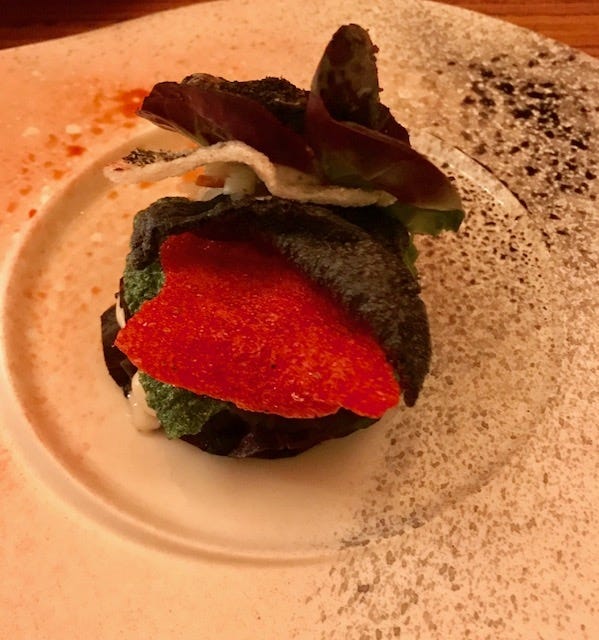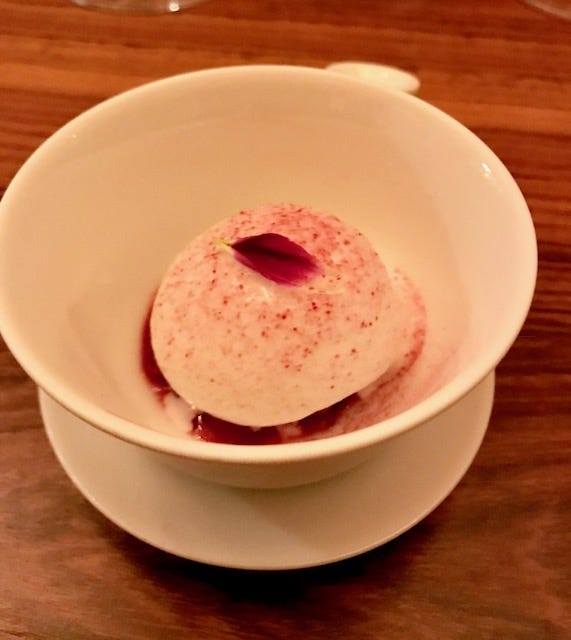Osteria Francescana, at Last!

This is Massimo Bottura. If you're reading this, you probably know that his small restaurant in Modena, Osteria Francescana, has three Michelin stars and was voted the best restaurant in the world on the Pellegrino scale. You might also know that he's a chef with an extremely interesting mind and a huge heart, who is deeply involved with feeding the hungry of the world.
I've known (and admired) both Massimo and his elegant American wife Lara Gilmore for a while now, but somehow I've never made it to Modena. Until yesterday.
Leave it to me to go to a four hour lunch on a day of such intense heat the newspaper headlines all read "Dangerous even for the animals." (For the record, it hit 107 degrees.) And this is not, I might mention, a restaurant you drive to; Modena is an ancient city and cars are not allowed inside the city walls (unless you live there). So we arrived parched and almost dizzy with heat.
Within seconds, we'd forgotten everything but the pure pleasure of listening to Massimo and Lara discuss their various projects (a refettorio in London, another in Burkina Faso and a gelateria in a refugee camp in Greece) - and the meal they were about to serve us.
Blown away. That's my instant review. If you want more, keep reading.
These were just the tiny starting amuses bouches: This first is called, in homage to Magritte, "ceci n'est pas une sardine."

But of course, it is, at least partly, a sardine sandwich... all crunch, crackle and salt.

Corn stuffed with ceviche. Except, the corn is actually meringue, so you eat it first with shock, and then delight. "To be a cook," says Massimo, "you have to travel. Taste. Remember."
There were six or seven other tiny tastes - all deeply textured, each a single, powerful bite that resonated in your mind. And then the show really began with Massimo's version of insalata di mare.

Hidden inside the tiny head of lettuce were more leaves; biting in you discovered that each was a crisp little cracker made of a traditional dish like impepata di cozze (peppered mussels). Tender little bits of seafood were tucked between the layers of cracker, hidden away to make each bite a new delight.
Another surprise: instead of wine, we drank a Japanese limoncello with this: Tsuruume Yuzu. Best version I've ever encountered.

Perhaps the most traditional dish of the day - cool spaghetti cooked like risotto. The pasta itself has been transformed until it is no longer a mere vehicle for sauce. In the cooking each strand has absorbed the liquid, becoming one with the sauce and forcing you to experience pasta in a whole new way.
-
"Fontana," says Massimo - who obviously has great affection for the next dish, "was cutting and Burri was burning. " (He is talking about the two greatest artists of the arte povera movement of the fifties and sixties.) " I had it in mind to make sole, and I thought about both of them. So I made edible paper out of dehydrated sea water, and then burned it...." This result is this explosion of whiteness.

It is even more delicious than it looks. So delicious that a Japanese artist insisted on creating the perfect plate. This is the result.

I regret to tell you that I liked the eel course that arrived next so much that I'd inhaled it before giving it a chance to pose for its portrait. The slim filet of eel was surrounded by a cool green puddle of concentrated apple on one side and a little beige pool of gently burnt polenta on the other; a pile of ashes huddled at the bottom of the eel. "In my idea," said Massimo, "it is the story of the Este family who in 1594 moved the capital from Ferrara to Modena." A wild animal is surrounded by all the foods of the region - but they've been moved, manipulated, transformed. The sweet tart concentrated apple cut through the richness of the fish while the slight graininess of polenta anchored it to the earth and the bitter char of the burnt vegetables hovered above like an angry angel.
Massimo is back, gesturing with his hands as he tells us how he conceived the next dish. "My mind is mixing Piero della Francesca - beautiful gold leaves - and Pistoletto seven hundred years later. But I'm also thinking of stainless steel in the sixties, and how people use tin foil."
Okay - fine explanation - but who else would think that and serve this?

Hidden beneath that edible gold foil is the most extraordinary melange: minuscule rounds of turned potatoes intertwined with sweet, briny, tiny oysters swimming in a deep beurre blanc. It becomes a dance of textures as the softness of the oysters twirl up against the crispness of the potato.
This next dish has a completely different artist godfather. This time it is Warhol and his camouflage.

"I put together green and black risotto, but then I thought what is missing?" Massimo muses. "We have the sea and the flatland, but where are the tawny hills?
Think of this as an edible landscape - all the elements of the earth turned into three risottos. "Eat them all at once!" Massimo cries. How boring it will be, from now on, to eat a single risotto on its own.
We'd been drinking wine - cool Trebiannos, a Provencal rose, even a sauternes for the rich oyster dish - but with the risotto another surprise appears: an herbal drink with a serious kick. This is what I thought: in this bitterness, delight.

Massimo calls his next little masterpiece "Autumn in New York, Spring in Kyoto, Summer in Modena."
In trying to express the place where he is - right this moment - Massimo strolls through farmers markets of the world, meeting chefs, reveling in produce, living in the moment. And somehow this dish - intense tomatoes, almost burnt eggplants, a dashi made of local vegetables, evolves.

Modena is a city devoted to tortellini. The tiny, excruciatingly difficult to construct little dumplings are everywhere. Massimo fills his with bone marrow, mortadella and veal before bathing them in a rich parmesan cream. "I'm having a contest with David Chang," he exults, "dumpling versus tortellini. I won't say who won." He chuckles wickedly. And no wonder: it is hard to imagine anything more delicious than this.

The main course, perhaps most playful of all, is a duck that flies across the world, stopping along the journey to forage for food. So many flavors represented here - a touch of corn, a bit of horseradish, a hint of ginger, a whisper of rose. The leg is deconstructed and made into a meatball.

Cherry season in Modena. Here are three different kinds ranging from sweet to sour, along with ricotta cheese. Cherry pie is very jealous.

Massimo makes popcorn!

And finally, Italy's most famous dessert turned into a souffle. Tiramisu, reconsidered, reconstructed, reinvented. So good.


The final flavor is the best version of chocolate covered cherries the world has ever known. Each bite detonates in your mouth, delivering a burst of fresh, tart cherry juice. The complex flavor resonates on and on, like a bell that you feel to the bottom of your toes, even when you are back outside in the blazing sun, winding your way through the ancient streets of this beautiful city.
It's been quite a journey.




